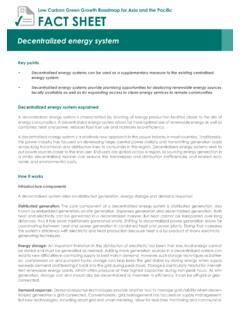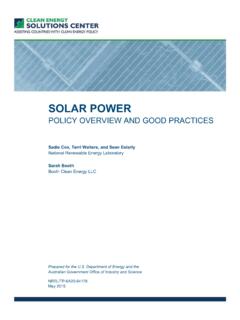Transcription of Property-Value Impacts Near Utility-Scale Solar Installations
1 Policy Research Project (PRP), LBJ School of Public Affairs, The University of Texas at Austin, May 2018. Project Director: Dr. Varun Rai 1 An Exploration of Property-Value Impacts Near Utility-Scale Solar Installations Leila Al-Hamoodah, Kavita Koppa, Eugenie Schieve, D. Cale Reeves, Ben Hoen, Joachim Seel and Varun Rai Abstract Nationwide, electric utilities increasingly rely on Solar Installations as part of their energy portfolio. This trend begs the question of how they affect nearby home values. Understanding whether these Installations are amenities or disamenities and the scale thereof will help policymakers, Solar developers, and local utilities to site and build Solar Installations with minimal disruption to nearby communities.
2 This paper investigates where large Solar Installations are located, the housing and income characteristics of the surrounding areas, and if the Installations affect nearby residential property values. We approach these questions using geospatial analysis and a survey of residential property assessors. Geospatial analysis examines both housing density and median income surrounding these facilities, while the survey gauges local assessors opinions of the Impacts of these Installations on property values. Property values can be a useful proxy for various non-market goods like scenic value, tax benefits, and of particular interest here, both positive and negative perceptions of Utility-Scale Solar facilities.
3 Our results show that while a majority of survey respondents estimated a value impact of zero, some estimated a negative impact associated with close distances between the home and the facility, and larger facility size. Regardless of these perceptions, geospatial analysis shows that relatively few homes are likely to be impacted. Though only one component of a larger analysis, these property value Impacts are likely to be of growing interest as more Solar facilities are built. This exploration of Impacts will help inform Solar developers, public officials, home assessors, and homeowners about the effects and implications of Solar energy infrastructure.
4 Introduction The installation of Utility-Scale Solar facilities continues at a rapid pace across the United States, with over ten gigawatts of new photovoltaic (PV) capacity installed in 2016 alone (Bollinger et al., 2017: p. 1; Perea et al., 2016). These Utility-Scale PV Installations , often informally called Solar farms (Fehrenbacher, 2016; New York State PV Trainers Network, 2017), are defined here to include Installations one megawatt (MWAC) and larger. Like other power plants, these Utility-Scale Solar Installations have the potential to impact nearby home values. The potential adverse impact on home prices due to the installation of Solar utilities is relevant to Solar developers, public officials, home appraisers, and homeowners, yet no peer-reviewed literature has directly addressed the subject to date.
5 The primary research question is: Do Utility-Scale Solar PV Installations impact the value of nearby homes? This study contributes to the existing literature on amenities and disamenities Policy Research Project (PRP), LBJ School of Public Affairs, The University of Texas at Austin, May 2018. Project Director: Dr. Varun Rai 2 by extending the research to Utility-Scale Solar PV Installations . Amenities are considered to be features that increase the value of a home, while disamenities have the opposite effect. The information in this study tackles relevant issues for Solar stakeholders and identifies questions for future research.
6 Background and Literature Review Residential housing literature covers a broad range of amenities and disamenities, including open-space and water views (Anderson & West, 2006; Bond et al., 2002), as well as landfills, coal-fired power plants, shale gas production facilities, oil and sour gas facilities, and transmission lines (Anderson et al., 2007; Des Rosiers, 2002; Case et al., 2006; Muehlenbachs et al., 2014; Davis, 2008; Locke, 2012), respectively. Research on High Voltage Transmission Lines (HVTLs), for example, has found adverse effects on proximate home values to be present in some analyses, while not in others, and, in general to be sensitive to micro-siting differences (Anderson et al.)
7 , 2007; Des Rosiers, 2002). Alternatively, research on power plants and natural gas facilities has found that increasing proximity to the disamenity correlates to a greater change in property values (Davis, 2008; Boxall, 2005). In the case of Utility-Scale wind turbines, much of the available research in the has not found consistent or compelling evidence of sales price Impacts on homes (Hoen et al., 2015; Hoen & Atkinson-Palombo, 2016; Lang & Opaluch, 2013). In fact some studies have documented wind turbines connection to increased property tax revenues to local school districts (and local taxing entities), which might be connected to increased property values by extension (Loomis & Aldeman, 2011).
8 Additional benefits of Utility-Scale wind can include job growth, supply industry growth, landowner profits, and road improvement, most of which are an effect of increased tax revenue from the large Installations (Loomis et al., 2016). Recent survey results suggest that residents living near wind facilities prefer living next to a wind turbine over more conventional energy infrastructure, such as coal, nuclear and natural gas (Hoen et al., 2018). Respondents in the same survey who lived within a half a mile of a wind project expressed similar preferences between living next to a wind (37 percent) or a Solar facility (24 percent), with roughly a third having no opinion, but these differences were not statistically significant.
9 This, therefore, suggests that disamenity research on wind s effects on property values, a proxy for local preferences, might provide a reasonable basis for comparison to Utility-Scale Solar facilities. To the best of the authors knowledge, no existing peer-reviewed research provides quantitative evidence of property value Impacts associated with Utility-Scale Solar facilities, but existing studies address related areas. Previous research on residential PV Installations , for example, has indicated that buyers place a premium on homes with PV systems (Hoen et al., 2017). In addition, available literature has explored public opinions surrounding Utility-Scale Solar Installations and perceived property value Impacts .
10 A survey by Carlisle et al. found that around 80 percent of survey respondents support the development of large-scale Solar facilities both in the generally, and within their own county (2015). However, this survey also Policy Research Project (PRP), LBJ School of Public Affairs, The University of Texas at Austin, May 2018. Project Director: Dr. Varun Rai 3 indicated that 70 percent of respondents believe these Installations will decrease property values. A public opinion survey on Solar facilities by the Idaho National Laboratory found that 43 percent of respondents in the southwest United States believed that a view of a large-scale Solar facility would decrease the value of their home, while 23 percent believed it would increase the value (Idaho National Laboratory, 2013).



